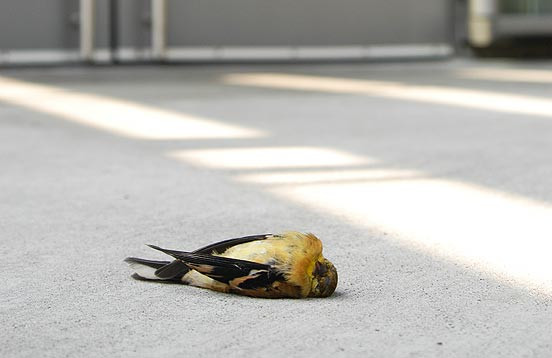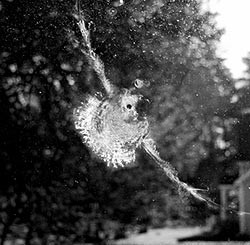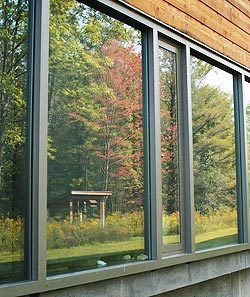Window collisions are a significant threat to bird populations. It’s estimated that up to one billion birds die each year in the U.S. alone from striking windows. These seemingly invisible barriers reflect sky and vegetation, deceiving birds into thinking they are clear pathways. Even if a bird appears to fly away after a collision, it may succumb to internal injuries later. Fortunately, there are many effective and simple strategies you can implement to significantly reduce this danger around your home and protect our feathered friends.
 American Goldfinch sadly deceased due to window collision
American Goldfinch sadly deceased due to window collision
Understanding Why Bird Window Strikes Happen
Birds collide with windows for a few key reasons, primarily during both day and night.
Daytime Collisions: During the day, the primary culprit is reflection. Windows mirror the surrounding environment, particularly trees, foliage, and the sky. Birds perceive these reflections as real habitats and attempt to fly towards them, resulting in a collision with the glass. They may also see through windows to indoor plants or vegetation on the other side, further contributing to daytime strikes.
Nighttime Collisions: Nocturnal migrating birds, which include the majority of songbirds, are particularly vulnerable at night. Artificial lights from buildings and urban areas disorient these migrants, especially during foggy or low-ceiling conditions. Drawn off course by the light pollution, they become confused and may collide with lighted structures and windows. Furthermore, birds attracted to urban lights at night may then face the hazard of daytime window reflections the following day. Initiatives like the BirdCast project and the Fatal Light Awareness Program (FLAP) are dedicated to addressing this issue of light pollution and bird collisions.
Territorial Aggression: Less commonly, birds may attack their own reflections in windows, especially during spring breeding season when territoriality is heightened. While this behavior can be disruptive for homeowners, it is usually not life-threatening for the bird. Many of the solutions designed to prevent general window strikes also effectively deter this territorial behavior.
 Window imprint left by a Mourning Dove after collision, highlighting the impact of bird strikes
Window imprint left by a Mourning Dove after collision, highlighting the impact of bird strikes
Simple Steps to Make Your Windows Bird-Safe
Identifying hazardous windows is the first step in preventing collisions. Pay close attention to large windows, picture windows, corner windows, and any windows near bird feeders or with views of vegetation. Step outside your home and observe your windows from a bird’s perspective. If you see reflections of trees, sky, or greenery, these are potential collision points. Contrary to previous beliefs, the distance of bird feeders from windows is less critical than making the windows themselves bird-friendly.
 Reflection of trees and sky in a window, a dangerous illusion for birds leading to collisions
Reflection of trees and sky in a window, a dangerous illusion for birds leading to collisions
Effective Treatments for Existing Windows
Several treatments can be applied to existing windows to make them visible to birds and prevent collisions. For smaller birds, markings should ideally be spaced no more than 2 inches apart. For greater visibility, like with Acopian BirdSavers, spacing can be up to 4 inches. Crucially, all treatments must be applied to the exterior surface of the window.
- Paint or Soap: A cost-effective and simple method is to use tempera paint or soap to create patterns on the outside of your windows. A 2×2 inch grid pattern is effective, or you can use your creativity to design patterns or artwork.
- Window Decals and Stickers: Apply decals, stickers, sun catchers, mylar strips, or even masking tape to the exterior of your windows. For these to be effective, they must be densely spaced, covering most of the glass surface with gaps too narrow for birds to fly through. Hawk silhouettes alone are not effective deterrents.
- Dot Patterns and Specialized Tapes: Long-lasting tape products with pre-spaced dot patterns offer an easy way to apply correctly spaced markings. Products like Feather Friendly are designed specifically for bird collision prevention.
- Acopian BirdSavers (Zen Curtains): These consist of closely spaced cords hanging vertically down the window. They are highly effective, aesthetically pleasing, and easier to install than tapes or decals. The Cornell Lab of Ornithology headquarters utilizes Acopian BirdSavers to protect birds. You can purchase pre-made BirdSavers or create your own.
- External Screens: Installing mosquito screens over your windows is a very effective solution, provided they are mounted on the outside and cover the entire window surface.
- Netting: Cover windows with netting, positioned at least 3 inches away from the glass and taut enough to deflect birds. Small mesh netting (around 5/8″ or 1.6 cm) is recommended to prevent entanglement while ensuring birds bounce off safely. Netting can be attached to a frame for easier installation and removal.
- One-Way Transparent Film: Films like Collidescape are designed to allow outward visibility from inside while making the window appear opaque from the outside. These films can also reduce light transmission, potentially lowering cooling costs.
Design Considerations for New Homes and Remodeling
When building a new home or remodeling, consider incorporating bird-friendly design elements to minimize window collision risks.
- External Shutters: Install external shutters and close them when rooms are unoccupied or when natural light and views are not needed. Shutters also offer energy-saving benefits.
- External Shades and Awnings: Install external sunshades or awnings to reduce window reflections. Remote-controlled options are available for convenience.
- Window Screens: For new construction, consider windows designed with screens covering the entire exterior glass surface.
- Interior Vertical Blinds: Use interior vertical blinds and keep the slats partially closed to break up reflections.
- Minimize Visual Pathways: Avoid creating direct visual paths through your house to outdoor greenery or sky. Bright windows facing each other can create the illusion of a clear passage. Closing interior doors or using window shades can mitigate this effect.
Lights Out Initiatives for Nighttime Migrants
Lights Out programs are gaining momentum in cities across the U.S., including major migratory routes. Excessive nighttime lighting in urban areas is a major hazard for migrating birds, disorienting them and increasing collision risks. Participating in Lights Out initiatives by turning off non-essential lights and using downward-facing outdoor lighting significantly reduces the problem of artificial light pollution at night. However, even with city-wide initiatives, individual homeowners should still implement window collision prevention methods.
How to Help a Bird That Has Hit a Window
If you find a bird that has collided with a window, immediate action can improve its chances of survival. Even seemingly unharmed birds may have internal injuries. The best course of action is to seek help from a wildlife rehabilitation facility.
If you find a stunned bird:
- Capture and Contain: Approach the bird gently from behind and carefully cover it with both hands. Be prepared for fluttering or vocalizations. Handle small birds delicately, ensuring your grip is secure but not tight.
- Prepare a Container: Find an unwaxed paper bag or a small cardboard box lined with tissue paper or paper towels to provide grip. Place the bird in the container and close it securely.
- Provide a Safe Environment: Keep the container in a dark, quiet, warm location away from children and pets.
- Do Not Offer Food or Water: Avoid handling, feeding, or watering the bird, as this can cause further stress. Wild birds perceive humans as predators.
- Contact a Wildlife Rehabilitator: Locate a nearby wildlife rehabilitator through an online directory and contact them for instructions. They may be able to provide guidance or arrange transport.
- Release (If Instructed): If the rehabilitator advises release, take the bird to a wooded area or suitable habitat away from buildings. Before releasing, observe its flight ability. Open the container in the direction of vegetation. If the bird doesn’t fly strongly, recapture it and contact the rehab facility again.
By taking these preventative steps and knowing how to assist injured birds, you can contribute significantly to bird conservation and create a safer environment for wildlife around your home.